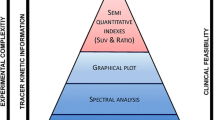Summary.
The central distinguishing feature of positron emission tomography (PET) is its ability to investigate quantitatively regional cellular and molecular transport processes in vivo with good spatial resolution. This review wants to provide a concise overview of the established principles underlying quantitative data evaluations of the acquired PET images. Especially, the compartment modelling framework is discussed on which virtually all quantification methods utilized in PET are based. The aim of the review is twofold: first, to provide the reader with an idea of the theoretical framework and mathematical tools and second, to enable an intuitive grasp of the possibilities and limitations of a quantitative approach to PET data evaluation. This should facilitate an understanding of how PET measurements translate into quantities such as regional blood flow, volume of distribution, and metabolic rates of specific substrates.
Similar content being viewed by others
References
JB Bassingthwaighte (1977) ArticleTitlePhysiology and theory of tracer washout technique for the estimation of myocardial blood flow estimation from tracer washout. Prog Cardiovasc Dis 20 165–189 Occurrence Handle335437 Occurrence Handle1:STN:280:DyaE1c%2Fjtlemsg%3D%3D Occurrence Handle10.1016/0033-0620(77)90019-6
Bassingthwaighte JB, Goresky CA (1984) Modeling in the analysis of solute and water exchange in the microvasculature. In: Handbook of physiology, sect. 2. The cardiovascular system, vol. IV. The microcirculation, chap. 13. American Physiological Society, Bethesda, pp 549–626
JB Bassingthwaighte GA Holloway SuffixJr (1976) ArticleTitleEstimation of blood flow with radioactive tracers. Semin Nucl Med 6 141–161 Occurrence Handle775641 Occurrence Handle1:STN:280:DyaE287pvFeqsA%3D%3D
JB Bassingthwaighte IS Chan CY Wang (1992) ArticleTitleComputationally efficient algorithms for convection-permeation-diffusion models for blood-tissue exchange. Ann Biomed Eng 20 687–725 Occurrence Handle1449234 Occurrence Handle1:STN:280:DyaK3s%2FotVarsg%3D%3D
JB Bassingthwaighte B Winkler RB King (1997) ArticleTitlePotassium and thallium uptake in dog myocardium. J Nucl Med 38 264–274 Occurrence Handle9025754 Occurrence Handle1:CAS:528:DyaK2sXhsFSrsr4%3D
G Blomqvist (1984) ArticleTitleOn the construction of functional maps in positron emission tomography. J Cereb Blood Flow Metab 4 629–632 Occurrence Handle6334095 Occurrence Handle1:STN:280:DyaL2M%2FlsFaiuw%3D%3D
Carson RE (2003) Tracer kinetic modeling in PET. In: Valk PE, Bailey DL, Townsend DW, Maisey MN (eds) Positron emission tomography. Springer, London, pp 147–179
Carson RE, Cunningham V, Gunn RN, van den Hoff J, Knudsen GM, Lammertsma AA, Leenders KL, Maguire RP, Müller-Schauenburg W (2003) PET pharmacokinetic course. In: Maguire RP, Leenders KL (eds) PET Pharmacokinetic course manual, University of Groningen, Groningen, The Netherlands and McGill University, Canada Montreal
Jones T (2003) Historical development of functional in vivo studies using positron-emitting tracers. In: Valk PE, Bailey DL, Townsend DW, Maisey MN (eds) Positron emission tomography. Springer, London, pp 3–40
SS Kety CF Schmidt (1948) ArticleTitleThe nitrous oxide method for the quantitative determination of cerebral blood flow in man: theory, procedure and normal values. J Clin Invest 27 476–483
Lassen N, Perl W (1979) Tracer kinetic methods in medical physiology. Raven Press, New York
J Logan JS Fowler ND Volkow AP Wolf SL Dewey DJ Schlyer RR MacGregor R Hitzemann B Bendriem SJ Gatley et al. (1990) ArticleTitleGraphical analysis of reversible radioligand binding from time-activity measurements applied to [N-11C-methyl]-(−)-cocaine PET studies in human subjects. J Cereb Blood Flow Metab 10 740–747 Occurrence Handle2384545 Occurrence Handle1:CAS:528:DyaK3cXmtVOmu7Y%3D
CS Patlak RG Blasberg JD Fenstermacher (1983) ArticleTitleGraphical evaluation of blood-to-brain transfer constants from multiple-time uptake data. J Cereb Blood Flow Metab 3 1–7 Occurrence Handle6822610 Occurrence Handle1:STN:280:DyaL3s7gvFegtA%3D%3D
Press WH, Teukolsky SA, Vetterling WT, Flannery BP (1992) Numerical recipes in C. Cambridge University Press, Cambridge
J van den Hoff W Burchert W Müller-Schauenburg GJ Meyer H Hundeshagen (1993) ArticleTitleAccurate local blood flow measurements with dynamic PET: fast determination of input function delay and dispersion by multilinear minimization. J Nucl Med 34 1770–1777 Occurrence Handle8410297 Occurrence Handle1:STN:280:DyaK2c%2FhsFCgtw%3D%3D
ATM Willemsen J van den Hoff (2002) ArticleTitleFundamentals of quantitative PET data analysis. Curr Pharm Des 8 1513–1526 Occurrence Handle12052209 Occurrence Handle1:CAS:528:DC%2BD38XkvVWksrg%3D Occurrence Handle10.2174/1381612023394359
Author information
Authors and Affiliations
Rights and permissions
About this article
Cite this article
van den Hoff, J. Principles of quantitative positron emission tomography. Amino Acids 29, 341–353 (2005). https://doi.org/10.1007/s00726-005-0215-8
Received:
Accepted:
Published:
Issue Date:
DOI: https://doi.org/10.1007/s00726-005-0215-8




